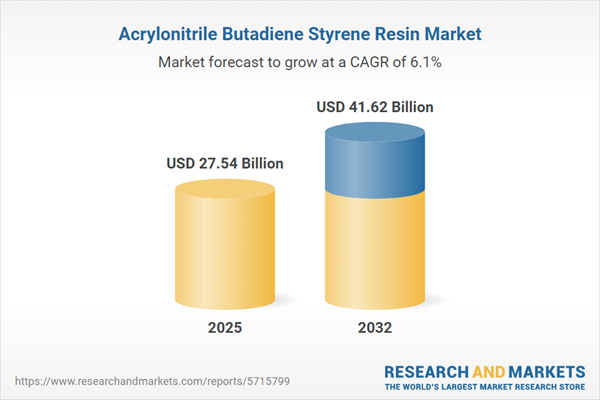Speak directly to the analyst to clarify any post sales queries you may have.
Acrylonitrile butadiene styrene resin, valued for its durability, adaptability, and suitability for evolving operational needs, remains a cornerstone in modern manufacturing strategies. Senior decision-makers are leveraging these material advancements to improve process efficiency, address regulatory complexities, and adapt to global shifts in supply and technology.
Market Snapshot: Acrylonitrile Butadiene Styrene Resin Market Outlook
The acrylonitrile butadiene styrene resin market holds a vital role as a reliable material across automotive, electronics, and infrastructure sectors. Market value stability and a proven compound annual growth rate position ABS resin as a source of consistent process stability and operational continuity. The integration of innovations such as additive manufacturing and 3D printing has driven diversified production options, meeting the growing demand for both customized and large-scale manufacturing. Companies increasingly require agile solutions, and manufacturers are responding by aligning material capabilities with sector-specific applications and shifting regulatory landscapes, ensuring high performance in demanding environments.
Scope & Segmentation
- Application Areas: ABS resin supports requirements in automotive components, construction materials, electrical systems, advanced 3D printing, and consumer products. Each area demands unique compliance measures, technical specifications, and logistic arrangements, prompting the need for targeted solutions that maximize performance in specialized use cases.
- Grades: Available grades include high heat, flame retardant, food grade, general purpose, and glass fiber-reinforced ABS. This broad range supports adaptation to stringent performance, safety, and application standards, vital for sectors such as electronics and food packaging.
- Processing Methods: Key manufacturing processes, including injection molding, extrusion, and blow molding, enable both high-volume production and flexible, adaptive manufacturing in response to evolving global requirements.
- Sales Channels: Organizations can utilize both offline distribution and digital procurement platforms, improving transparency, procurement efficiency, and the ability to meet shifting buyer expectations across regions and market segments.
- Geographic Coverage: Coverage includes North America, Latin America, Europe, Middle East, Africa, and Asia-Pacific. Notably, China, India, Japan, and Southeast Asia contribute deeply through sector expertise and diverse supply frameworks, boosting overall supply chain agility and responsiveness.
- Industry Players: Primary participants include INEOS Styrolution Group GmbH, LG Chem Ltd., Saudi Basic Industries Corporation, The Dow Chemical Company, LyondellBasell Industries N.V., Trinseo Materials LLC, Chi Mei Corporation, BASF SE, Mitsubishi Chemical Corporation, and Sumitomo Chemical Company Limited. Their advancements and cooperative standards shape ongoing technical development across the industry.
Acrylonitrile Butadiene Styrene Resin Market: Key Takeaways for Senior Decision-Makers
- Suppliers are advancing bio-based feedstocks and recycling methods, aligning with global sustainability targets and supporting the transition to circular economy practices.
- Implementation of digital manufacturing, including real-time analytics, drives operational agility and accelerates launches of new products across industrial supply chains.
- Enhanced materials engineering, such as improved thermal properties and reinforced ABS, unlocks new opportunities for core sector product development.
- Regional investment varies, with some markets intensifying focus on compliance, traceability, and adapting infrastructure in response to changing regulations.
- Electronics, mobility, and advanced manufacturing players are adopting robust supply chain and procurement strategies to adapt to shifting industry trends and consumer expectations.
- Strategic partnerships between original equipment manufacturers and suppliers foster product consistency and enable rapid alignment with emerging standards and new market demands.
Tariff Impact and Supply Chain Strategies
Recent tariff developments in the U.S. affecting acrylonitrile butadiene styrene resin imports are prompting organizations to reassess sourcing and inventory approaches. Businesses are diversifying supplier bases with increased engagement in Southeast Asia and Latin America and are reinforcing inventory buffers to counter volatility. Initiatives such as nearshoring, centralized procurement, and closer supplier relationships are central to ensuring reliable manufacturing output in the face of regulatory and logistics challenges.
Methodology & Data Sources
Insights in this report are based on direct sector specialist input, thorough technical benchmarking, and review by key industry authorities. This process ensures that senior executives access actionable guidance grounded in current, validated industry knowledge and operational realities.
Why This Report Matters
- Enables leaders to anticipate regulatory adjustments, strengthen supply chain stability, and mitigate procurement risks in complex and volatile global markets.
- Guides strategic alignment with sustainability and digital transformation, supporting enterprise-wide resilience and competitive positioning.
- Delivers relevant, executive-level analysis on technical and market developments for proactive decision-making and market differentiation.
Conclusion
By applying the provided strategic and technical insights, senior decision-makers can optimize ABS resin utilization, foster product innovation, and enhance organizational agility within fast-changing manufacturing landscapes.
Additional Product Information:
- Purchase of this report includes 1 year online access with quarterly updates.
- This report can be updated on request. Please contact our Customer Experience team using the Ask a Question widget on our website.
Table of Contents
3. Executive Summary
4. Market Overview
7. Cumulative Impact of Artificial Intelligence 2025
Companies Mentioned
The companies profiled in this Acrylonitrile Butadiene Styrene Resin market report include:- INEOS Styrolution Group GmbH
- LG Chem, Ltd.
- Saudi Basic Industries Corporation
- The Dow Chemical Company
- LyondellBasell Industries N.V.
- Trinseo Materials LLC
- Chi Mei Corporation
- BASF SE
- Mitsubishi Chemical Corporation
- Sumitomo Chemical Company, Limited
Table Information
| Report Attribute | Details |
|---|---|
| No. of Pages | 187 |
| Published | October 2025 |
| Forecast Period | 2025 - 2032 |
| Estimated Market Value ( USD | $ 27.54 Billion |
| Forecasted Market Value ( USD | $ 41.62 Billion |
| Compound Annual Growth Rate | 6.0% |
| Regions Covered | Global |
| No. of Companies Mentioned | 11 |









